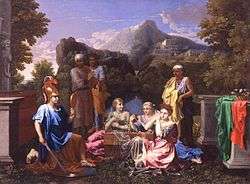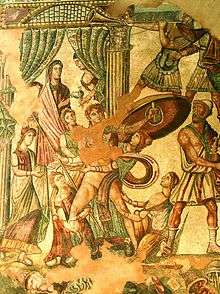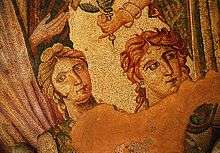Achilles on Skyros
Achilles on Skyros is an episode in the myth of Achilles, a Greek hero of the Trojan War. Not existing in Homer's epic poem Iliad, the episode is written down in detail in some later versions of the story, particularly the Achilleid by the Roman poet Statius. The story of how Achilles disguised himself as a girl at the court of the king of Skyros, fell in love with one of the princesses, and married her before leaving for Troy, became a popular topic in arts and literature from Classical times until the middle of the 20th century. The carnavalesque disguises and gender transpositions at the heart of the story were particularly popular in opera, with over 30 different operas on the theme between 1641 and 1857.
Story
The core myth of Achilles on Skyros as presented in ancient sources was thus. Rather than allow her son Achilles to die at Troy as prophesied, the nymph Thetis sent him to live at the court of Lycomedes, king of Skyros, disguised as another daughter of the king or as a lady-in-waiting, under the name Pyrrha "the red-haired", Issa, or Kerkysera. There Achilles had an affair with Deidamia, one of the daughters of Lycomedes, and they had one or two sons, Neoptolemus and Oneiros.[1] Since another prophecy suggested that the Trojan War would not be won without Achilles, Odysseus and several other Achaean leaders went to Skyros to find him. Odysseus discovered Achilles by offering gifts, adornments and musical instruments as well as weapons, to the king's daughters, and then having his companions imitate the noises of an enemy's attack on the island (most notably, making a blast of a trumpet heard), which prompted Achilles to reveal himself by picking a weapon to fight back, and together they departed for the Trojan War. In some versions, Deidamia dressed as a man followed him.[2][3]
The most detailed and elaborate version is that found in the Roman poem Achilleid.[4] In the poem, Thetis resolves to hide Achilles away at the court of Lycomedes. Achilles is quite reluctant, but eventually consents, attracted by the beauty of the king's most fair daughter, Deidamia. Thetis has him dressed up as a maiden and introduces him to Lycomedes as her daughter who would have had an Amazon-like upbringing and now needed to learn feminine ways by living among ordinary girls of her age, so as to prepare for a normal marriage in the future; Lycomedes agrees to take care of the "girl" and his unsuspecting daughters accept Achilles into their company as another fellow maiden. After some time he develops a particularly close friendship with Deidamia and it becomes increasingly difficult for him to hide his romantic and sexual interest in her. Eventually, at a nighttime festival in honor of Dionysus where men are normally not allowed, Achilles gives way to his manly desires and forces Deidamia to have sex with him. Afterwards, trying to console her, he discloses his true name and origin; despite being scared by what has happened, Deidamia doesn't want Achilles to suffer punishment from her father and resolves to keep the incident and his identity, as well as the fact that she has conceived a child, a secret. When Odysseus and his comrades arrive at Scyros, Achilles, long annoyed by his female disguise, is about to reveal himself but Deidamia holds him back. Odysseus then performs the trick with the gifts and the trumpet and thereby reveals the secret. Achilles hears Deidamia cry and confesses to Lycomedes that they have become lovers and have had a child together. As the Achaeans are about to sail off to the war, Deidamia is heartbroken over the impending loss of Achilles and asks if she could go with him, but that seems impossible; she then implores him to keep their son in his thoughts, and to never have children with other women. Achilles swears to one day return to Deidamia, but the reader knows that he will die at Troy.
Artistic renditions

This part of the Trojan War myths has been the subject of many works of art throughout the centuries. Taken from the point of view of Achilles, Deidamia, or a neutral observer, a number of themes have received attention in the later artwork and stories, ranging from the comical aspects of crossdressing and the misunderstandings it involves, over gender differences, heroism, homosexual and heterosexual love, and initiation rites, to rape, incest, and domestic violence.[3][5]
While most later versions go essentially back to the 1st century CE version of Statius, the story of Achilles on Skyros was known earlier than this. There are references to artworks by Polygnotus and Athenion of Maroneia, and a now lost 5th century BCE play by Euripides.[6]
One of the earliest and best studied Renaissance versions of the story was Tirso de Molina's 1612 play El Aquiles.[3][6][7] It was followed by a number of other Spanish plays on the same topic. One of its foci was the change in Achilles from fleeing war to being a war hero. This was emphasized by the many changes and transformations used in the play. But the more typical themes of gender confusion and homosexual love are also apparent, and strengthened by the indication that the role of Achilles should be played by a woman.[7][8]
.jpg)
It has often been used as the theme for an opera or ballet, with the libretto by Metastasio as the most popular. The first opera based on this story seems to have been La finta pazza by Francesco Sacrati, with a libretto by Giulio Strozzi. It was the first and probably the most popular opera of the seventeenth century. It was first performed at the inauguration in 1641 of the Teatro Novissimo in Venice, the first time ever a building was created specifically to perform operas. Anna Renzi was the main singer. The production then was performed many times all over Italy and abroad, including a 1645 performance in Paris, which was the second time ever that an opera was staged in France.[9]
The Metastasio libretto was first used for an opera in 1736 by Antonio Caldara, at the occasion of the marriage of Maria Theresa with the future Holy Roman Emperor, Francis I. Due to the short notice given for the marriage, the libretto was finished after only 18 days, compared to the three months Metastasio usually needed. Despite this, it enjoyed a reasonable success and was used for decades, set to music by at least 29 composers. Further version include the 1737 opera by Domenico Sarro, used for the inauguration of the Teatro di San Carlo, the opera house of Naples, and starring Vittoria Tesi.[10][11]
The popularity of the theme was due to a number of factors, but a major part was the aspect of disguises and crossdressing, with Achilles dressed as a girl and his role often performed by women. Some librettists, especially the earlier ones like Giulio Strozzi, Carlo Capece and Ippolito Bentivoglio approached this from a carnivalesque point of view, emphasizing the comedy, the masquerade and the (homo-)erotic aspects of it. Others like Metastasio or Paolo Rolli more focused on the failed struggle to conceal the masculinity of the archetypical hero Achilles, and how the inherent nature of the person is stronger than the nurture he receives.[9]
Well known composers writing an opera on this theme include Domenico Scarlatti with his 1712 Tetide in Sciro, John Gay's 1733 Achilles, and Georg Friedrich Händel in 1741 with Deidamia.[9]
Literature
- Ca. 1st century BCE: Epithalamium of Achilles and Deidameia, anonymous, sometimes ascribed to Bion of Smyrna
- 1st century CE: Achilleid by Statius
- 2nd century CE: The Speech of the Embassy to Achilles (Op. 16 Behr) by Aelius Aristides, section 17 (Behr)
- 11th century: Deidamia Achilli, an anonymous Ovidian epistle from Deidamia to Achilles[2]
- 14th century: the story is mentioned in the Divina Commedia by Dante, Purgatorio chapter 9 verse 34-42[2]
- 1805: Achille à Scyros by Jean-Charles-Julien Luce de Lancival
- 1890, Achilles in Scyros by Robert Bridges (2nd edition 1892)
- 1935: Achille ou le mensonge by Marguerite Yourcenar, also published as Déidamie
- 1995: "Achilles Speaks of His Deception in the Court of Lykomedes" by Michael Martone, first published in The American Voice, pp. 80–82. Republished in Four for a Quarter: Fictions,[12] pp. 135-137. Martone read the story at the Knox Writers House.[13]
- 1998: the story of Achilles on Skyros is included in the Age of Bronze comics by Eric Shanower
- 2011: a version of this story is included in the contemporary historical fiction novel The Song of Achilles by Madeline Miller.
Visual arts
Paintings

- 5th century BCE, Achilles in Skyros by Polygnotus
- 4th or 3rd century BCE: Athenion of Maroneia painted an image of Odysseus discovering Achilles in a maiden's clothing[14]
- 1st century BCE: the Chamber of Achilles on Skyros, decorated with frescoes, in the Domus Aurea
- 1st century CE: anonymous wall-paintings of Achilles in Skyros in the House of the Dioscuri and other places in Pompei[15]
- Early 17th century: Odysseus recognises Achilles (disguised as a woman) amongst the daughters of Lycomedes by Frans Francken the Younger
- 1649-50: Nicolas Poussin, Discovery of Achilles on Skyros[16]
- 1656: Nicolas Poussin, Achilles on Skyros
- 1664: Achilles discovered by Ulysses by Jan de Bray
- 17th century: Achilles and Ulysses Leaving Skyros by Claude François
- Niccolò Bambini, Achilles at Skyros
- Pieter van Lint, Achilles among the Daughters of Lycomedes, The Israel Museum, Jerusalem
- Gian Pietro Bellori, 2 paintings of Achilles in Skyros, one now in the Museum of Fine Arts, Boston, one in the Virginia Museum of Fine Arts, Richmond
- 18th century: Achilles at the Court of King Lycomedes with His Daughters by Pompeo Batoni
Tapestries
- Mid 18th century: Achille chez les filles de lycomède à Skyros, reconnu par Ulysse, now kept in the Hôtel de Soubise
Mosaics
- Achilles on Skyros, mosaic from Zeugma, Commagene
- "Achilles at Skyros discovered by Ulysses", mosaic from [(Villa Romana La Olmeda, Spain)]
Sculptures
_-_MR_2113_-_Philibert_Vigier_-_(1636-1719)_-_All%C3%A9e_Royale_-_Versailles_-_P1620078.jpg)
- 1695: Achille à Scyros by Philibert Vigier, located at the Tapis Vert of the Gardens of Versailles
Stage
Plays
- 5th century BC: Skyrioi by Euripides (lost, but described as a play about Achilles hiding on Skyros)
- 1612: El Aquiles by Tirso de Molina[3]
- Ca. 1640: El caballero dama (The Gentleman as a Lady) by Cristóbal de Monroy y Silva[3]
- 1653: El monstruo de los jardines (The Monster of the Gardens) by Pedro Calderón de la Barca[3]
Opera
- 1641: La finta pazza by Francesco Sacrati (music) and Giulio Strozzi (libretto)[9]
- 1663: Achille in Sciro by Giovanni Legrenzi (music) and Ippolito Bentivoglio (libretto)[9]
- 1663: Achille in Sciro by Antonio Draghi (music) and Cav. Ximenez (libretto)
- 1712: Tetide in Sciro by Domenico Scarlatti (music) and Carlo Sigismondo Capece (libretto)[9]
- 1727: Achille in Sciro, anonymous work performed at the opera house of Franz Anton von Sporck in Prague, and probably based on the Bentivoglio libretto
- 1733: Achilles by John Gay[9]
- 1735: Achille et Déidamie by André Campra (music) and Antoine Danchet (libretto)
- 1736: Achille in Sciro by Antonio Caldara (music) and Metastasio (libretto)
- 1737: Achille in Sciro by Domenico Sarro (music) and Metastasio (libretto)
- 1738:Achille in Sciro by Giuseppe Arena (music) and Metastasio (libretto)
- 1739: Achille in Sciro by Pietro Chiarini (music) and Metastasio (libretto) (adapted by Bartolomeo Vitturi
- 1740: Achille in Sciro by Leonardo Leo[17]
- 1741: Deidamia by George Frideric Handel (music) and Paolo Antonio Rolli (libretto)
- 1744: Achille in Sciro by Francesco Corselli (music) and Metastasio (libretto)
- 1745: Achille in Sciro by Gennaro Manna (music) and Metastasio (libretto)
- 1747: Achille in Sciro by Giovanni Battista Runcher (music) and Metastasio (libretto)
- 1749: Achille in Sciro by Niccolò Jommelli (music) and Metastasio (libretto)
- 1751: Achille in Sciro by Gregorio Sciroli (music) and Metastasio (libretto)
- 1754: Achille in Sciro by Antonio Maria Mazzoni (music) and Metastasio (libretto)
- 1759: Achille in Sciro by Johann Adolph Hasse (music) and Metastasio (libretto)
- 1759: Achille in Sciro by Giuseppe Sarti (music) and Metastasio (libretto)
- 1764: Achille in Sciro by Ferdinando Giuseppe Bertoni (music)
- 1765: Achille in Sciro by Johann Friedrich Agricola (music) and Metastasio (libretto)
- 1766: Achille in Sciro by Florian Leopold Gassmann (music) and Metastasio (libretto)
- 1767: L'Achille in Sciro by Johann Gottlieb Naumann
- 1772: Achille in Sciro by Antonio Amicone
- 1773: Achilles in Petticaots by Thomas Arne (music) and John Gay (libretto)
- 1774: Achille in Sciro by Pasquale Anfossi (music) and Metastasio (libretto)
- 1774: Achille in Sciro by Pietro Pompeo Sales (music) and Metastasio (libretto)
- 1778: Achille in Sciro by Giovanni Paisiello
- 1785: Achille in Sciro by Gaetano Pugnani
- 1794: Achille in Sciro by Marcello Bernardini and Metastasio (libretto)
- 1800: Achille in Sciro: Commedia dramatica per musica, libretto by Publio Quintiliano Settimio
- 1825: Achille in Sciro by Pietro Antonio Coppola (music) and Rapisarda (libretto)
- 1857: Achille à Scyros by François Anatole Laurent de Rillé (operette)
Ballet
- 1804: Achille à Scyros by Pierre Gardel (ballet) and Luigi Cherubini (music)
- 1830: Achilles at Scyros by Carlo Blasis
- 1921, Achilles auf Skyros by Egon Wellesz (music) after Hugo von Hofmannsthal
Notes
- Oneiros is only mentioned by Ptolemy Hephaestion (New History Book 3, summarized in Photius, Bibliotheca, 190); generally, all sources speak of one son, Neoptolemus
- Hagedorn, Suzanne C. (2003). Abandoned Women: Rewriting the Classics in Dante, Boccaccio, and Chaucer. University of Michigan Press. p. 232. ISBN 9780472113491. Retrieved 9 October 2012.
- De Armas, Frederick Alfred (1998). A Star-Crossed Golden Age: Myth and the Spanish Comedia. Bucknell University Press. p. 247. ISBN 9780838753767. Retrieved 10 October 2012.
- Book 1, passim
- Callen King, Catherine (2004). "Achilles on the Field of Sexual Politics". Subversive Subjects: Reading Marguerite Yourcenar. Fairleigh Dickinson Univ Press. p. 252. ISBN 9780838639924. Retrieved 9 October 2012.
- Shecktor, Nina Maria (2009). The Achillean Hero in the Plays of Tirso De Molina. Peter Lang. p. 127. ISBN 9780820433103. Retrieved 10 October 2012.
- DiPuccio, Denise M. (1998). "El Aquiles and the Making of a Hero". Communicating Myths of the Golden Age Comedia. Bucknell University Press. p. 236. ISBN 9780838753729. Retrieved 10 October 2012.
- Stroud, Matthew D. (2007). Plot Twists and Critical Turns: Queer Approaches to Early Modern Spanish Theater. Bucknell University Press. p. 267. ISBN 9780838756690. Retrieved 16 October 2012.
- Heslin, P. J. (2005). The Transvestite Achilles: Gender and Genre in Statius' Achilleid. Cambridge University Press. p. 370. ISBN 9780521851459. Retrieved 4 October 2012.
- Menchelli-Buttini, Francesca (2006). "Achille in Sciro: Drama and Ceremony". In Melania Bucciarelli, Norbert Dubowy and Reinhard Strohm (ed.). Italian Opera in Central Europe, Volume 1. BWV Verlag. pp. 253–274. ISBN 9783830503811. Retrieved 4 October 2012.
- Metastasio's libretto for a 1774 performance, on Google Books
- Martone, Michael (2011). Four for a Quarter: Fictions. FC2.
- Martone, Michael. "Recording of "Achilles Speaks of His Deception in the Court of Lykomedes"". Knox Writers House. Retrieved August 27, 2016.
- Pliny the Elder, Natural History 35.134
- Trimble, Jennifer F. (2002). "Greek Myth, Gender, and Social Structure in a Roman House". The Ancient Art of Emulation: Studies in Artistic Originality and Tradition from the Present to Classical Antiquity. University of Michigan Press. p. 320. ISBN 9780472111893. Retrieved 5 October 2012.
- "Discovery of Achilles on Skyros". Museum of Fine Arts Boston. Retrieved 16 October 2012.
- Score of the Leonardo Leo opera at Google Books
External links
![]()



